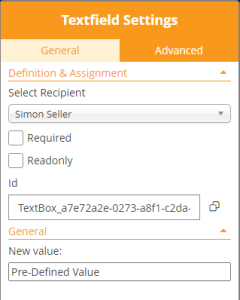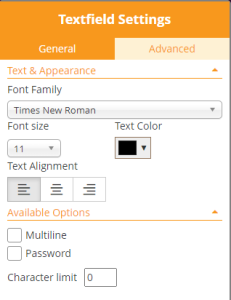The designer page shows all formerly added (or recognized) interactive fields on the documents and allows to interactively place additional interactive fields.
The Designer screen is showing following elements:
- Standard menu bar
on the very left side, by default collapsed.
Menu items have been explained in the first chapters of the Application Reference - WebUI. - The Recipients List
- The elements toolbox with
- Form Field Elements
- Predefined (static value) Fields
- The main editor
- The page preview section
(on the right side) - Properties Panel
to configure element properties; visible only when an element is selected and in property-editor mode. - Wizard Navigation Bar (bottom)
UI Areas of the Designer explained in Detail
In this chapter, we are explaining the UI elements and their behavior in detail. We are not covering
Recipients List
Shows the list of all recipients and automatic-signature activities.
Allows to select to which recipient elements that are added later-on are assigned, and can be used to re-assign the element currently selected in the Main Editor.
Elements Toolbox
Form Field Elements
Predefined (static value) Fields
Main Editor
WYSIWYG-Editor to place form elements, re-arrange and resize them.
Page Preview
Shows the structure of documents and their pages contained in the envelope, and previews locations of signature fields on the document.
Properties Panel
On devices without touch capabilities, the user can open the properties panel by selecting (clicking) an element in the Main Editor area. On tablet PCs (or in general on devices with touch input), the user must click on the cogwheel icon on an element's adhoc menu to open the properties panel. When the properties panel is open, the user can change settings, but needs to confirm or cancel the properties panel before other UI changes (e.g. arranging of elements) can be done in the UI.
Wizard Navigation Bar
The navigation control of the wizard, with following buttons while on the Designer Page:
- Arrow-Back, navigates to the recipients page
- Discard, which deletes (after confirmation dialog) the draft
- Save-As
- Template, allowing to create a new Template based on the data configured for the Draft
- Draft, persisting the changes made on the draft and returning back to the Envelope Filter View.
- Sign-Button, visible and accessible only when the first signer of an envelope is the sender
- Next-Button, proceeds to the Summary Page
Element Properties
Let's have a deeper look into the properties of the elements which you can place using the Designer Page. When an element was placed on a document, and the element gets selected, the properties panel gets opened. Within the properties panel, different properties of the element can be defined. The properties which can be defined vary between different element types.
Properties of Textfield Elements
General Settings
Advanced Settings
The "Advanced" tab contains Text & Appearance configuration and several options of the Textfield.
In the Text & Appearance section, the sender can define
- Font Family
- Font size
- Text color
- Text Alignment
The font family defines which font should be used for rendering the text in the web browser, and also be used for filling form elements in the PDF. Keep in mind when working with languages that require usage of Unicode characters, that the font installed on the server must also support the entire (used) unicode charset - otherwise the entire text or some characters will be represented using replacement characters.


